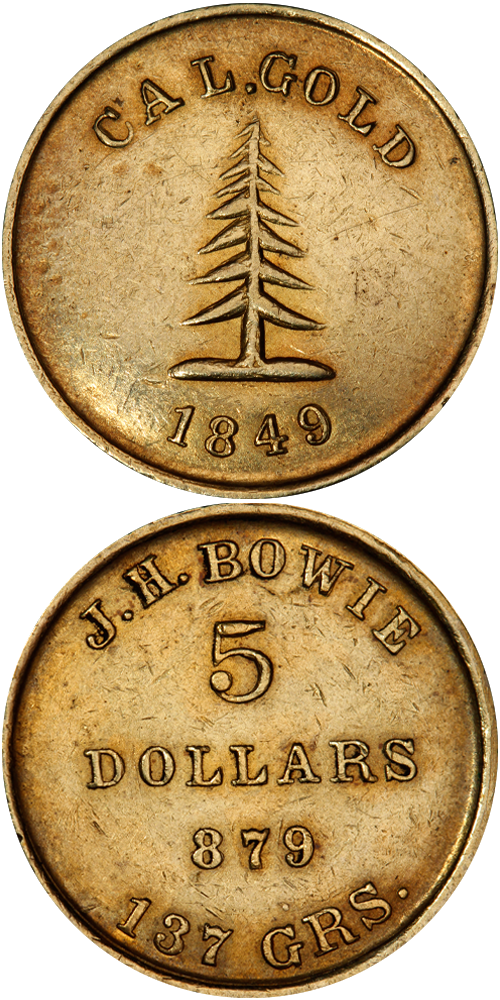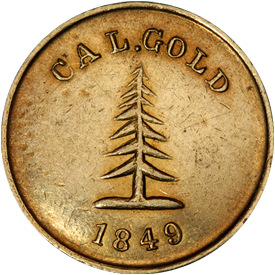Before the early 1980’s only one gold 1849 Bowie $5 was known, the specimen that had long been on display at the California Coinage Museum in the Bank of California’s San Francisco offices. At the time, it was considered to be unique and was so listed in Don Kagin’s Private Gold Coins and Patterns of the United States. Then, in 1983, Kagin announced the discovery of a second specimen in the September issue of the The Numismatist. At Kagin’s suggestion, the piece had been submitted to ANACS (as it was called, then) for authentication. After ANACS had officially authenticated the coin it was considered important enough to be featured on the front cover.
The third specimen is also a new discovery and appears nearly 17 years to the month after the second Bowie $5 was found. It, too, comes previously unheralded from a collection out west.
The three known 1849 Bowie $5 gold pieces were all struck from the same pair of dies. The obverse design shows a large pine tree in the center with CAL. GOLD around the top and the date 1849 around the bottom. The reverse has J.H. BOWIE at the top, the denomination 5 DOLLARS in the center, and the intended fineness 879 and weight 137 GRS. at the bottom.
The second known specimen (the 1983 discovery piece) was authenticated by ANACS, NGC, and most recently by PCGS. In 1998 the coin’s metallic content was analyzed by S&N Labs of Santa Ana, California for the Professional Coin Grading Service (PCGS) as part of the certification process. The coin was found to contain 88.4% gold and 11.6% silver and to weigh 135 grains. PCGS slabbed the coin as AU55. In September 2000, the newly discovered third specimen was analyzed by the same S&N Labs and found to contain 86% gold, 12% silver, and nearly 2%. iron.
The analyses make it pretty clear that the 1849 Bowie $5 gold pieces were struck from native California gold that still had not been parted from its considerable silver content. It is not difficult to figure out how much pure gold is contained in each coin. The second known specimen has 119.34 grains of pure gold and the third coin has 119.02 grains of pure gold. An 1849 federal $5 gold piece had 116.09 grains of pure gold in a total weight of 128.9 grains.
While no one knows how many $5 gold pieces Bowie may have made the number was certainly very small since only three survivors are known, today. It is possible that most of the Bowie $5’s were melted to make a profit on the marginally higher gold content.
Most of what is known about Bowie’s life story comes from research published by Don Kagin in 1983 and the references uncovered by researcher Dan Owens for his book California Coiners and Assayers.
Joseph Haskins Bowie was born in Georgetown, D.C. in 1816. He was raised on his family’s plantation in Montgomery County, Maryland. When he was in his early 30’s he plied the trade of gold and silversmith in Baltimore, Maryland and his name is listed in that city’s directories from 1840-45. After that date nothing is heard of J.H. Bowie until he is listed as a passenger, along with two of his cousins, aboard the St. Andrews bound March 12, 1849 for Chagres in Panama. From there, the Bowie party crossed the Isthmus to Panama City on foot since there was no rail crossing yet built. On the Pacific side the party could only find passage on a whaler out of Fairhaven, Massachusetts named the Sylph. She carried them to San Francisco, where they landed late in June, 1849.
In San Francisco, J.H. Bowie stayed with another cousin, Augustus Bowie, who ran a medical practice out of his home on the corner of Dupont and Clay Streets. This was across the street from the offices of Moffat & Co., the well known coiners. In June, 1849 Moffat & Co. were still making their $16 ingots but two months later the first of the Moffat $10’s began appearing, soon to be followed by the first Moffat $5’s. It is possible that Joseph H. Bowie became inspired to make his own $5 gold pieces after seeing one of Moffat's coins sometime in August, 1849. We do not know if Bowie's dies were made locally, in San Francisco, as Moffat’s were. On the other hand, Bowie may have brought the dies with him from Baltimore. The evidence is inconclusive either way. What is sure, however, is that there was ample time for Bowie to arrive in San Francisco, get the lay of the land, arrange for making his $5 gold pieces with a private mint, obtain the unparted bullion, and strike his small issue of coins before the end of 1849. In doing so, he joined the ranks of the few coiners who operated in the west in 1849.







